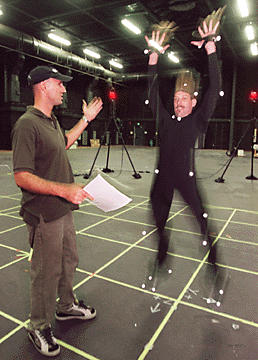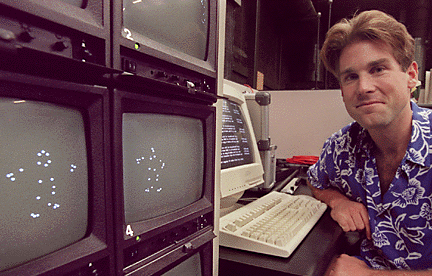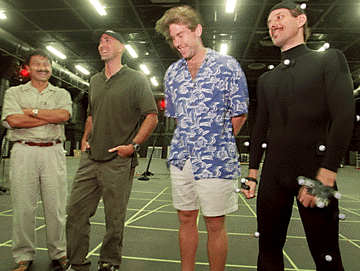


It’s reel Fantasy
This woman is created
By Tim Ryan
completely by computers and
exists only in 'Fantasy;' she's
going to be a movie star
Star-BulletinDOUGLAS David Walters looks like a reluctant warrior. Dressed in a skintight black body suit with a couple dozen white ping pong like balls attached from head to toe, Walters listens as motion capture line producer Remington Scott tells him how and where to run, jump, fall and turn on a specially marked, large grid in the Hawaii Film Studio's 16,000 square-foot sound stage.
Surrounding the grid are 10 specialized cameras -- similar to infra-red "but not exactly," Scott says -- which will photograph -- "sort of," Scott says. -- Walters movements. The "motion capture" is sent to computers a few feet away where Walters muscular body is transformed into white dots against a black background and a stick-like figure with what seems like perfect human motion.

Before the day is through, Walters will perform dozens of activities before these odd cameras made especially for Square USA. The cameras capture his bends and bows and twists and turns where the "balls" are located. Then the computer, operated and monitored by engineer Matt Karnes, connects the dots to give the figure a somewhat human form.Eventually, each moment of action is sent electronically downtown to Square's nerve center at Harbor Court where the company is forging technological history to make a film that "perfectly" simulates human emotions and movements through computer graphics, said Hironobu Sakaguchi, the film's director.
"It is beyond anything that has ever been done before," he said at the Harbor Court office. "I want to create entertainment that touches the imagination of new generations by setting the viewer on an exciting voyage of personal discovery."
The project embodies the very reason for which Square USA was created, Sakaguchi says: "To develop entertainment projects linking Hollywood and the latest in Japanese technology."
The characters are fully computer generated, nothing is scanned off a human. They are developed from original graphic designs, Sakaguchi said.

For the last 19 months, Square USA has occupied the top floors of Harbor Court, first renting two floors, then four, and now plans to rent two more. The Honolulu studio, which specializes in film and game production, employs 250 people -- 150 are working on the "Final Fantasy" film. The studio is equipped with more than $10 million in state-of the-art computer graphics equipment. Every desk top has a Silicon Graphics Octane work station, the creme de la creme for CG animators.The research center was developed to be the fountainhead for the next era in interactive entertainment, said Jun Aida, the film's producer and vice president of Square's film and entertainment division.
Some designers sit in high-ceilinged rooms beside enormous view windows that have been covered to prevent glare on the two or even three computer screens that sit on each desk.
On the mauka section of the floor, hundreds of hand-drawn story boards cover the walls, some marked "rejected," "possible," "in progress," or "approved." Designers sit six in a row staring at screens building backgrounds, futuristic chairs, vehicles, battlefields and weapons.
The studio gathered its talent from all over the world, including Hollywood, Tokyo and London. There are artists here who worked on "Godzilla" and "Titanic;" former Disney animators, an art director from "5th Element," and the computer graphics director responsible for the introduction sequences to Namco's Tekken 2nd Soul Blade.
The project is top secret. Entry to any of the main offices is by electronic key; cameras are mounted outside each entrance so "we know everyone who comes and goes," said Aida.

Designers work on renderings for the film's characters that go through hundreds of transformations, Aida and Sakaguchi said. Eventually, the images captured at the Hawaii Film Studio will be bonded into the final character designs to create "perfect computer generated human beings," Aida said.Published rumors in game magazines say the main character and hero will look like Brad Pitt. Sakaguchi and Aida declined comment except to say the characters are designed to appeal to as broad an audience as possible. The actors whose voices will be used will be selected by spring when dubbing begins, Aida said.
Sakaguchi declines discussing production costs, but says it would be impossible to create "the kind of world with the production values we're making in a (usual) live action film" because of the expense.
To overcome major technical problems Square designers and animators have created their own software. The accurate rendering of facial expressions, hair and wrinkles in clothing as the character moves has been a special challenge, Sakaguchi said.
"We have been developing proprietary equipment as well as our own software," Sakaguchi said. "We also have a contract with Alias Wavefront (one of the leading animation packages, used to create both motion picture and game graphics.)
To create a 3-5 minute scene to date takes one month of production, Aida said.
"We're not really there yet to do it more efficiently but we'll get there soon," he said.
A tired computer graphics designer huddles in front of a 21-inch monitor, meticulously design-ing a chair inside a space ship. As he moves the computer mouse in the smallest of increments, clicking here and there, one of several chair legs bends a bit, or the color changes slightly, or the chair turns three dimensionally.
It looks like, well, a really cool chair in a computer generated room filled with items. The designer has been working on the image for seven days.
The official Square USA explanation of "Final Fantasy: The Movie": The 90- to 100-minute movie is set on Earth in the year 2065 and is inspired by the Final Fantasy series of game titles. While not based on any specific Final Fantasy game title or story line, the movie will continue the idea of an "ultimate fantasy story about life and death" that forms the basis of the popular role-playing series, said Director Hironobu Sakaguchi. World where life's
a form of energyFrom what the Star-Bulletin saw in hundreds of story boards, there are a lot of battle scenes between groups and individuals using strange looking weaponry and modes of transportation from huge space ships to much smaller vehicles.
In the world of "Final Fantasy: The Movie," science has analyzed life and death, with life expressed as a form of energy, Sakaguchi said.
"What does it mean to be alive? What does it mean to die? In life, all things and all people die so we must all live with the knowledge that we will one day be separated from our loved ones," he said.
Jun Aida, the film's producer, said the film has human beings threatened by alien invasions; and science has advanced so much that it looks at life and spirits in a very scientific way.
"There are heroes like the special forces soldiers who try to save the world; there are scientists, and some love interests. The theme comes down to if we can't love one another, we can't solve this (problem) cooperatively to save the world."
The main characters are all American born, designed primarily with "American" features but have various ethnic backgrounds including African American and Asian, Aida said.
Rumors about "Final Fantasy: The Movie" published in numerous game magazines: An animator using the code name "Agent Shinra" for the full-length, fully-rendered film said the main character is tentatively named Grey and appears to look like Brad Pitt. The animator describes sequences of "Grey" riding hover bikes and firing laser guns in a densely populated area that could be New York City. There also are female character renderings that suggest love interests and even computer generated love scenes.
Hironobu Sakaguchi, director of "Final Fantasy: The Movie" and producer of the games Final Fantasy I-VIII Fantasy makers
According to Andrew Vestal in "The History of Final Fantasy," if the Final Fantasy series could be pinpointed as the product of one man's imagination, that man would be producer Hironobu Sakaguchi. He has watched over every stage of the series' development. Technology has grown by leaps and bounds since the series' inception, and so, for that matter, has each game's staff. But Sakaguchi's vision has been the glue that has held each game together.
He has led the development division since joining Square Co. Ltd. in 1986. He has produced more than 30 million units of computer game software worldwide, with his smash hit Final Fantasy series selling more than 17 million.
Jun Aida, vice president of Square's Film and entertainment division, and producer of "Final Fantasy: The Movie"
Serving as director of licensing for Capcom USA, in 1994 Aida produced "Street Fighter," the live action box office hit that grossed more than $100 million worldwide. Aida later supervised the film's distribution, marketing and promotion in North America, Europe, Latin America and Australia. Aida also produced the successful animated TV series "Street Fighter,"
"MegaMan," and 'Dark Stalkers."
Al Reinert, scriptwriter for "Final Fantasy: The Movie"
After a career as a newspaper journalist and magazine writer, Reinert made the successful jump to writing for feature films. "For All Mankind," which he produced, won the Audience Award at the 1989 Sundance Film Festival. In 1995 he was nominated for an Academy Award for "Apollo 13."
Andy Jones, Animation Director
He studied both traditional animation and computer generated animation at UCLA and later was employed by Digital Domain, working on television commercial products. He served as lead animator on three projects before becoming animation supervisor for "Titanic" and "Godzilla."
This promises to be an exciting year for Hironobu Sakaguchi, the genius behind the "Final Fantasy" computer games. Version "VIII" is about to be released and the much talked about multimillion-dollar "Final Fantasy: The Movie," which Sakaguchi is directing, is being produced in Hawaii. The film is scheduled for release in the summer 2001. Very compliant actors, indeed
There seems to be an awe directed toward Sakaguchi by the inhabitants of the four floors Square USA occupies at Harbor Court in downtown Honolulu. This is where 250 animators, designers and programmers work on his visions.Sakaguchi, 37, recently discussed "Final Fantasy: The Movie," the ground breaking technology behind the film, and Square's vision for future applications of that technology.
SB: Why did you want to make a film using computer generated human beings rather than a traditional film with real actors?HS: (laughing) Sometimes human actors can be very selfish and not listen to the director and producer. But our actors are always willing to work on time and take direction.
Actually after the success of the Final Fantasy games, I really wanted to create an unprecedented, new form of entertainment that fuses the technical wizardry of computer games with the visual effects of motion pictures ...
We are producing the first computer-generated, animated motion picture with photo-real human characters. The goal is to convey human emotions and movements more realistically than any current computer-generated feature.
SB: But you actually do use real actors don't you?
HS: Oh, yes. All the movements are made with hu-mans (filmed at the Hawaii Film Studio) then the characters are computer generated, designed at the downtown facility. ...
SB: What has been the most difficult aspect technically of making this film?
HS: Natural human facial expressions. To have the skin and hair move naturally like it does in reality. Also the way clothes wrinkle when people move. That is very, very hard to simulate realistically. If you produced wrinkles by hand animation it would take probably 10 years. So we created our own software to accomplish this. ...
SB: It sounds like a lengthy, tedious process?
HS: Yes. ...It takes about one month of production to produce 3-5 minutes of film.
SB: If "Final Fantasy: The Movie" is successful will you do a sequel or prequel and will you also produce it in Hawaii?
HS: (Smiling) Oh yes!
The Final Fantasy game series is the unchallenged leader among interactive role-playing games and is largely responsible for the tremendous growth in the popularity of these titles. No illusion:
The ultimate champ
of interactive gamesThe concept behind the Final Fantasy series is the creation of the ultimate fantasy. High quality graphic images created with top technological innovation give the game player a personalized role in a fantasy story based on adventure, love, friendship, dreams and life.
Square Co. Ltd. introduced The first game in the Final Fantasy series in 1987 for the Nintendo Entertainment System. With 520,000 units sold, the game's immediate success became the foundation for the modern role-playing industry.
Building on the success of the game's first version, other Final Fantasy versions followed. In 1996, Square broke ranks with Nintendo and set up an exclusive relationship with Sony.
Final Fantasy VII's introduction in 1997 rewrote the record books. Square introduced the new version on CD-ROM format for the Sony PlayStation game console, a switch that enabled a whole new level of graphic images. This new graphics sophistication allowed Sony to promote PlayStation to a new segment of the market.
First week sales of Final Fantasy VII were 2 million, with worldwide sales eventually topping 6 million. Square's production budget of $26 million for Final Fantasy VII was unparallelled in the interactive entertainment industry.
Each Final Fantasy, at its heart, is defined by its story and the characters who inhabit its world, says Andrew Vestal in "The History of Final Fantasy." The Earth is dying from within, and the people await the fulfillment of a prophecy: four warriors, each with an orb, will arrive to renew the world. These four warriors are the Light Warriors.
The game begins with standard fantasy mini-quests: rescue the princess, awaken the sleeping Elf King, placate the blind witch, dethrone an usurping pretender, and so on. There are heroes and villains.
In spite of their sequential nature, each Final Fantasy game is a self-contained adventure. Characters, locations, and storylines never carry over from one game to the next.
Square has announced Final Fantasy VIII will debut this year and is rumored to have an in-depth and detailed story line with more effective graphic expression. Contrary to its 32-bit predecessor, the characters in the game are all texture-mapped, meaning they will be more detailed in battle scenes.
CORRECTION
Feb. 3, 1999Several paragraphs in our January 15 report on Final Fantasy originated from GameSpot (http://www.gamespot.com), a leading online source of information about computer games, and were not attributed by the Star-Bulletin.
Andrew Vestal wrote "The History of Final Fantasy" feature, which can be found at
http://www.videogames.com/
features/universal/finalfantasy_hs/.We apologize for the error.
Click for online
calendars and events.